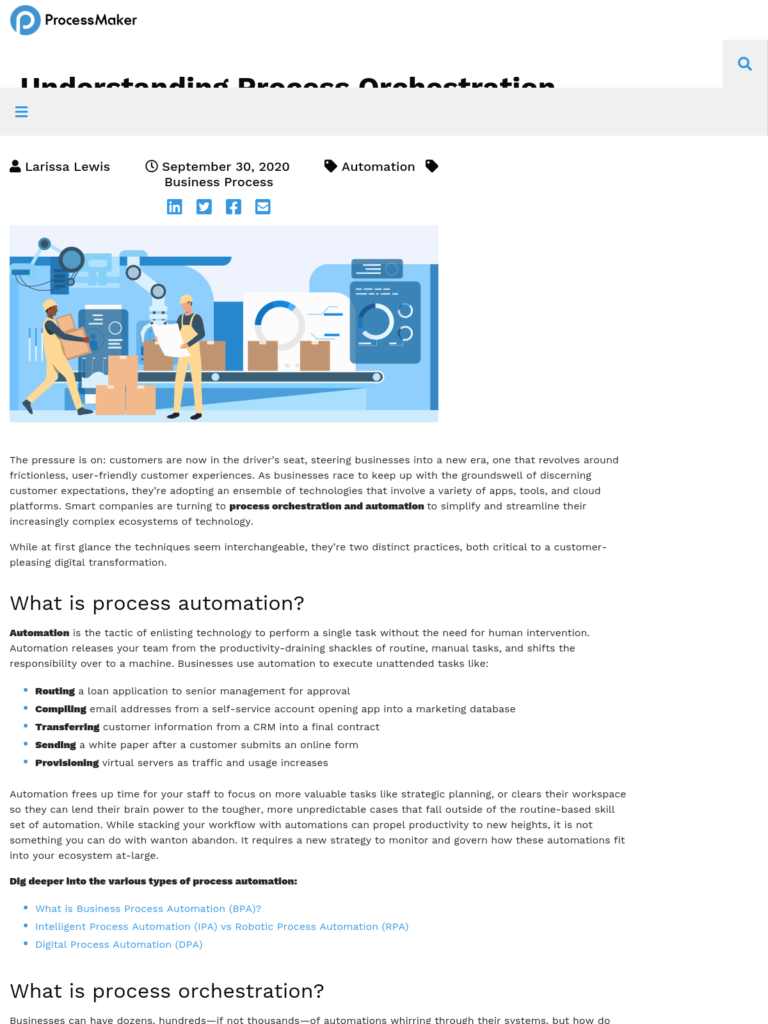Process Orchestration vs Automation
Blog: ProcessMaker Blog
The pressure is on: customers are now in the driver’s seat, steering businesses into a new era, one that revolves around frictionless, user-friendly customer experiences. As businesses race to keep up with the groundswell of discerning customer expectations, they’re adopting an ensemble of technologies that involve a variety of apps, tools, and cloud platforms. Smart companies are turning to process orchestration and automation to simplify and streamline their increasingly complex ecosystems of technology.
While at first glance the techniques seem interchangeable, they’re two distinct practices, both critical to a customer-pleasing digital transformation.
What is process automation?
Automation is the tactic of enlisting technology to perform a single task without the need for human intervention. Automation releases your team from the productivity-draining shackles of routine, manual tasks, and shifts the responsibility over to a machine. Businesses use automation to execute unattended tasks like:
- Routing a loan application to senior management for approval
- Compiling email addresses from a self-service account opening app into a marketing database
- Transferring customer information from a CRM into a final contract
- Sending a white paper after a customer submits an online form
- Provisioning virtual servers as traffic and usage increases
Automation frees up time for your staff to focus on more valuable tasks like strategic planning, or clears their workspace so they can lend their brain power to the tougher, more unpredictable cases that fall outside of the routine-based skill set of automation. While stacking your workflow with automations can propel productivity to new heights, it is not something you can do with wanton abandon. It requires a new strategy to monitor and govern how these automations fit into your ecosystem at-large.
Dig deeper into the various types of process automation:
- What is Business Process Automation (BPA)?
- Intelligent Process Automation (IPA) vs Robotic Process Automation (RPA)
- Digital Process Automation (DPA)
What is process orchestration?
Businesses can have dozens, hundreds—if not thousands—of automations whirring through their systems, but how do these automations cooperate with one another? While automation is the tactic used to get things done, process orchestration is the strategy that governs its coordinated and efficient execution.
The practice of orchestration efficiently strings together an array of automations operating in disparate environments. Orchestration acts as the governing body of your technology suite, painting a full picture of how your organization runs, so you can cultivate better cooperation between workflows.
Efficiently sequence events
If you view your automations as independent nodes, it’s impossible to understand the complexity of the overall system. Using orchestration, you can identify themes between various tasks and properly sequence them for speed and efficiency.
Eliminate redundancies
Orchestration can help identify new opportunities for increased efficiency. Perhaps two workflows running in parallel perform the same task at the same time: orchestration can bridge discrete workflows to run a task once instead of twice.
Enact system-wide, standardized policies
With your automations under a single umbrella, you can easily deploy system-wide or regional measures like compliance requirements or security protections.
Orchestration brings all the automated processes within your organization under a single umbrella. Think of orchestration as the train conductor: it links the cars (automation tasks) together, sets the route, keeps everything moving the right speed, and enables open communication between the cars.
How process orchestration and automation fit together
A successful digital transformation requires both automation and orchestration. Automation helps remove manual tasks that bog down your customer experience, while orchestration brings them all of the moving parts together into a well-oiled, systematic engine. Working hand in hand, your company can realize significant benefits.
- Cost savings: Armed with a full understanding of each process in your system, you can lower IT costs and eliminate unnecessary resource costs. Staff no longer needs to fix a single issue across multiple processes, but has the visibility needed to fix one instance. The powerhouse pair of orchestration and automation also enables your systems to dynamically scale, so you are only paying for the resources you’re consuming.
- More tightly regulated processes: If you have to make the same security update to each and every app or process within your suite, human errors are more likely to crop up. With everything under a single umbrella, you can enact mass policies that quickly trickle down to every automation within your system.
- Increased agility: Businesses constantly push to increase their time-to-market. Automation and orchestration open up a new market of cloud tools where you can handpick pre-built services instantly ready to expand your business or improve your customer experience.
As customers continue to demand more from the businesses they work with, the technologies behind these interactions become an increasingly complex puzzle. The dynamic duo of automation and orchestration empowers your organization with the visibility you need to coordinate and streamline your full suite of technologies to better serve your customers.
The post Process Orchestration vs Automation appeared first on ProcessMaker.
Leave a Comment
You must be logged in to post a comment.








